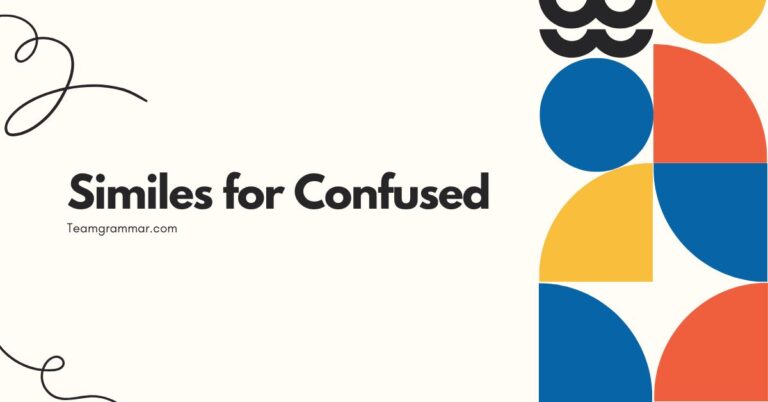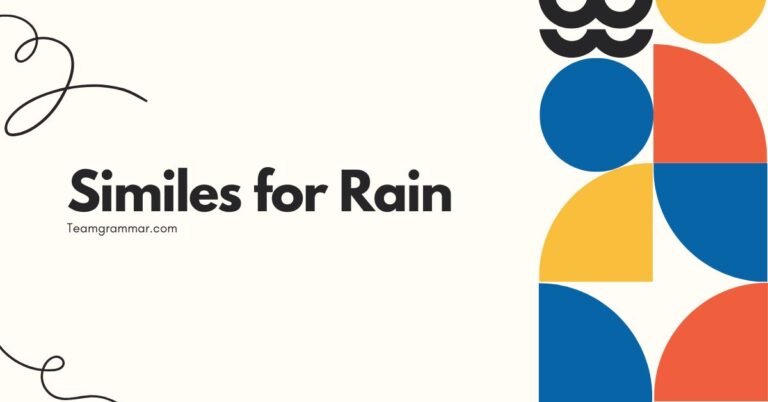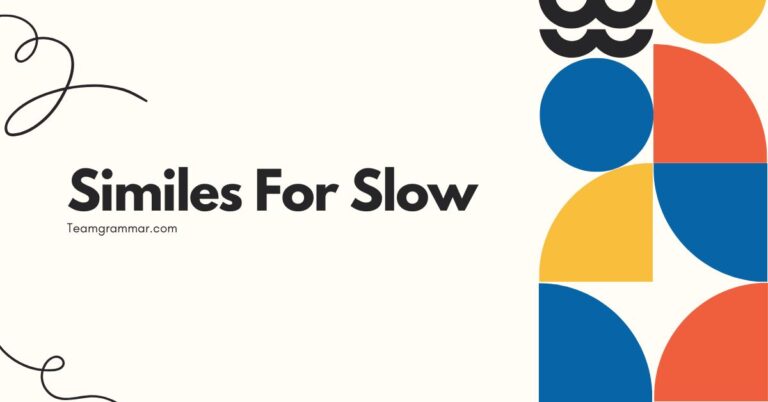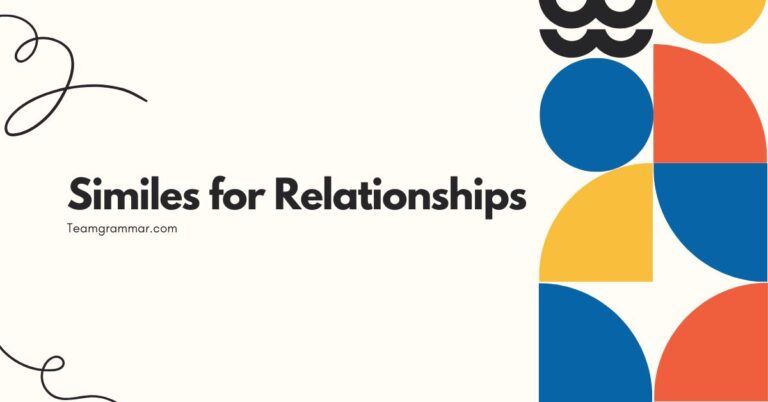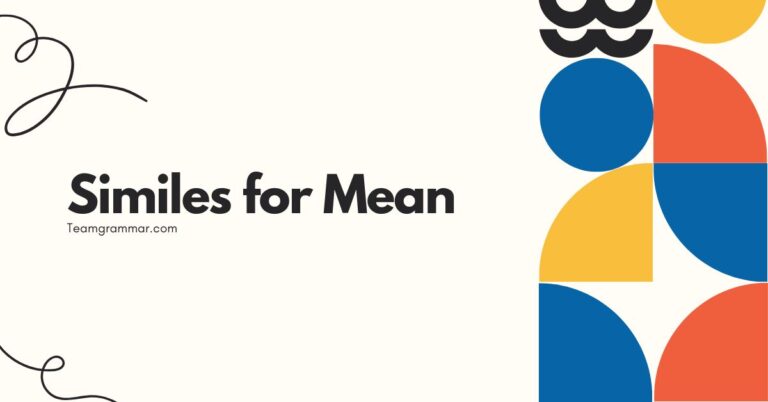41 Similes for Great: Enhancing Your English Vocabulary
Understanding and using similes effectively can significantly enhance your descriptive writing and speaking skills. Similes, which compare two different things using “like” or “as,” add color and vividness to your language.
This article focuses on similes that convey the idea of “greatness,” helping you to express excellence, magnitude, or importance in a more creative and engaging manner. Whether you’re a student, writer, or language enthusiast, mastering these similes will enable you to communicate with greater precision and flair, making your prose more compelling and memorable.
This comprehensive guide will explore various similes that capture the essence of “great,” providing definitions, examples, and practical exercises to solidify your understanding. By delving into the nuances of each simile, you’ll learn how to choose the most appropriate comparison to suit your intended meaning and context.
Get ready to elevate your language skills and discover the power of similes in expressing greatness.
Table of Contents
- Definition of a Simile
- Structural Breakdown of Similes
- Types of Greatness Conveyed by Similes
- Examples of Similes for Great
- Usage Rules for Similes
- Common Mistakes When Using Similes
- Practice Exercises
- Advanced Topics: Nuances and Subtleties
- Frequently Asked Questions
- Conclusion
Definition of a Simile
A simile is a figure of speech that compares two unlike things using the words “like” or “as.” The primary purpose of a simile is to create a vivid image or to emphasize a particular quality by drawing a comparison to something familiar or easily understood. Similes enhance writing by adding depth, color, and emotional resonance.
They are a fundamental tool in both creative and persuasive writing, allowing speakers and writers to express ideas in a more engaging and memorable way.
Unlike metaphors, which directly state that one thing *is* another, similes acknowledge the comparison explicitly. This difference in approach affects the overall tone and impact of the statement.
A simile offers a more nuanced comparison, suggesting a similarity rather than a complete equivalence. The effectiveness of a simile depends on the clarity and relevance of the comparison.
A well-chosen simile can transform a mundane description into something extraordinary, capturing the reader’s attention and leaving a lasting impression.
Structural Breakdown of Similes
The basic structure of a simile consists of three main components: the subject being described, the linking word (“like” or “as”), and the object to which the subject is being compared. Understanding this structure is essential for creating effective and meaningful similes.
The subject is the entity whose greatness you wish to emphasize. The linking word establishes the comparison.
The object provides a point of reference that the audience can easily grasp.
The formula is generally:Subject + Linking Word + Object of Comparison. For instance, in the simile “His achievements were as monumental as the pyramids,” “His achievements” is the subject, “as” is the linking word, and “the pyramids” is the object of comparison.
The object of comparison should be something that embodies the quality you want to highlight. The more apt and evocative the object, the more effective the simile will be.
Varying the structure slightly can also create different effects, but the core components remain the same.
Types of Greatness Conveyed by Similes
The concept of “greatness” is multifaceted, encompassing various aspects such as size, importance, skill, impact, and success. Similes can be tailored to reflect these different dimensions of greatness.
By understanding these nuances, you can select the most appropriate simile to convey your intended meaning accurately. This section categorizes similes based on the type of greatness they express, providing a framework for choosing the right simile for each context.
Similes for Size or Magnitude
These similes emphasize the largeness or extent of something. They are useful when you want to convey the sheer scale or scope of an object, event, or idea.
Examples include comparing something to a mountain, an ocean, or the universe. The key is to choose an object of comparison that is universally recognized for its immense size.
Similes for Importance or Significance
These similes highlight the weight or consequence of something. They are appropriate when you want to underscore the critical nature or far-reaching effects of an event, decision, or person.
Examples include comparing something to the cornerstone of a building, a pivotal moment in history, or a guiding star. The goal is to select an object that represents fundamental value or influence.
Similes for Skill or Ability
These similes emphasize the proficiency or talent of someone. They are useful when you want to showcase someone’s exceptional capabilities or expertise.
Examples include comparing someone to a virtuoso musician, a master craftsman, or a seasoned athlete. The focus is on choosing an object that embodies mastery and excellence.
Similes for Impact or Effect
These similes highlight the influence or consequences of something. They are appropriate when you want to emphasize the transformative power or lasting effects of an action, event, or idea.
Examples include comparing something to a ripple effect, a catalyst, or a tidal wave. The objective is to select an object that represents significant and widespread change.
Similes for Success or Achievement
These similes emphasize the accomplishment or triumph of someone or something. They are useful when you want to celebrate a victory or highlight a remarkable achievement.
Examples include comparing something to a gold medal, a crowning achievement, or a landmark victory. The aim is to choose an object that symbolizes success and recognition.
Examples of Similes for Great
This section provides extensive examples of similes categorized by the type of greatness they convey. Each category is presented with multiple examples in a table format, allowing for easy comparison and comprehension.
These examples serve as a practical guide for incorporating similes into your writing and speaking.
Similes for Great Size or Magnitude
These similes illustrate immense size or scale, helping to convey the vastness of something being described. The comparisons are drawn to objects or concepts widely recognized for their large dimensions.
| Simile | Explanation |
|---|---|
| As vast as the ocean | Implies an immeasurable expanse, like the sea. |
| As big as a mountain | Suggests a towering, imposing size. |
| As immense as the universe | Conveys an infinite and boundless scale. |
| As wide as the horizon | Indicates a seemingly endless breadth. |
| As tall as a skyscraper | Represents a significant vertical height. |
| As expansive as a desert | Suggests a broad, open area. |
| As voluminous as a library | Implies a large quantity or capacity. |
| As gigantic as a whale | Represents an enormous size, like the largest sea creature. |
| As colossal as a statue of a god | Conveys a massive and awe-inspiring size. |
| As substantial as a fortress | Suggests a solid and significant size. |
| As limitless as the sky | Implies an unbounded and unrestricted scope. |
| As deep as a canyon | Represents a profound and extensive depth. |
| As broad as a continent | Suggests a wide and encompassing range. |
| As sweeping as a panorama | Conveys a comprehensive and extensive view. |
| As mountainous as his ego | Implies an inflated and exaggerated sense of self-importance. |
| As spacious as a football field | Represents a large and open area. |
| As astronomical as the national debt | Suggests an incredibly large and unmanageable amount. |
| As ample as her heart | Implies a generous and abundant capacity for love and compassion. |
| As boundless as his ambition | Conveys an unlimited and insatiable desire for achievement. |
| As endless as the sea of stars | Represents an infinite and never-ending expanse. |
| As massive as an elephant | Suggests a large and imposing size. |
| As considerable as the task ahead | Implies a significant and demanding undertaking. |
| As extensive as the research project | Represents a thorough and comprehensive study. |
Similes for Great Importance or Significance
These similes highlight the critical nature or far-reaching consequences of something, emphasizing its importance. The comparisons are drawn to objects or concepts widely recognized for their fundamental value or influence.
| Simile | Explanation |
|---|---|
| As crucial as the cornerstone of a building | Implies a fundamental and indispensable role. |
| As vital as the heart to the body | Suggests an essential and life-sustaining function. |
| As significant as a historical turning point | Conveys a pivotal and transformative moment. |
| As essential as oxygen to life | Indicates an absolutely necessary and vital element. |
| As critical as a doctor in an emergency | Represents a crucial and indispensable role in a crisis. |
| As foundational as the roots of a tree | Suggests a fundamental and deeply rooted importance. |
| As integral as the wheels to a car | Implies an essential and inseparable part. |
| As paramount as national security | Represents the highest level of importance and priority. |
| As indispensable as water to a plant | Conveys an absolutely necessary and irreplaceable element. |
| As consequential as a Supreme Court decision | Suggests a far-reaching and significant impact. |
| As valuable as a priceless artifact | Implies an immeasurable and irreplaceable worth. |
| As influential as a world leader | Represents a powerful and impactful force. |
| As momentous as a wedding day | Suggests a significant and memorable occasion. |
| As noteworthy as a Nobel Prize | Conveys a remarkable and prestigious achievement. |
| As meaningful as a heartfelt apology | Implies a sincere and impactful gesture. |
| As remarkable as a scientific breakthrough | Represents a significant and groundbreaking discovery. |
| As profound as a philosophical insight | Suggests a deep and insightful understanding. |
| As weighty as a moral dilemma | Conveys a serious and challenging situation. |
| As pivotal as the invention of the printing press | Implies a transformative and revolutionary event. |
| As imperative as following safety regulations | Represents an absolutely necessary and mandatory action. |
| As vital as sleep to a healthy body | Suggests an essential and restorative function. |
| As pressing as the need for clean water | Implies an urgent and crucial requirement. |
| As critical as the evidence in a trial | Represents a crucial and decisive factor. |
Similes for Great Skill or Ability
These similes showcase exceptional capabilities or expertise, highlighting someone’s proficiency. The comparisons are drawn to objects or concepts widely recognized for their mastery and excellence.
| Simile | Explanation |
|---|---|
| As skilled as a surgeon | Implies a high level of precision and expertise. |
| As talented as a virtuoso musician | Suggests exceptional musical ability and artistry. |
| As adept as a master craftsman | Conveys skillful and proficient craftsmanship. |
| As proficient as a seasoned athlete | Indicates a high level of athletic skill and experience. |
| As masterful as a chess grandmaster | Represents strategic thinking and exceptional skill in chess. |
| As gifted as a prodigy | Suggests innate talent and exceptional ability from a young age. |
| As capable as an experienced engineer | Implies competence and expertise in engineering. |
| As accomplished as a renowned artist | Represents skill and success in artistic endeavors. |
| As competent as a qualified teacher | Conveys proficiency and expertise in teaching. |
| As expert as a financial analyst | Suggests knowledge and skill in financial matters. |
| As nimble as a ballerina | Implies grace and agility in dance. |
| As sharp as a tack | Represents quick wit and intelligence. |
| As precise as a watchmaker | Suggests meticulous attention to detail and accuracy. |
| As smooth as a jazz musician’s solo | Conveys effortless skill and improvisation. |
| As inventive as an eccentric scientist | Represents creative and innovative thinking. |
| As analytical as a detective | Implies a methodical and thorough approach to problem-solving. |
| As resourceful as a survival expert | Suggests the ability to overcome challenges with limited resources. |
| As articulate as a public speaker | Conveys the ability to express oneself clearly and effectively. |
| As strategic as a military general | Represents tactical thinking and leadership skills. |
| As intuitive as a seasoned psychologist | Implies an understanding of human behavior and emotions. |
| As creative as an avant-garde artist | Suggests innovative and unconventional artistic expression. |
| As perceptive as a literary critic | Conveys the ability to analyze and interpret complex texts. |
| As disciplined as a martial arts master | Represents dedication and self-control in martial arts. |
Similes for Great Impact or Effect
These similes highlight the influence or consequences of something, emphasizing its transformative power. The comparisons are drawn to objects or concepts widely recognized for their significant and widespread change.
| Simile | Explanation |
|---|---|
| As impactful as a tidal wave | Implies a powerful and overwhelming effect. |
| As transformative as a butterfly emerging from its chrysalis | Suggests a complete and radical change. |
| As profound as a spiritual awakening | Conveys a deep and life-altering experience. |
| As far-reaching as a ripple effect | Indicates consequences that spread widely. |
| As influential as a revolutionary idea | Represents a groundbreaking and transformative concept. |
| As potent as a catalyst | Suggests the ability to initiate significant change. |
| As pervasive as a cultural shift | Implies a widespread and deeply ingrained change in society. |
| As resonating as a heartfelt speech | Represents an emotional impact that lingers. |
| As disruptive as a technological innovation | Conveys a change that disrupts existing norms and practices. |
| As seismic as a major earthquake | Suggests a sudden and dramatic impact. |
| As life-changing as winning the lottery | Implies a significant and transformative event. |
| As liberating as breaking free from oppression | Represents freedom and empowerment. |
| As empowering as gaining self-confidence | Conveys a sense of strength and capability. |
| As illuminating as a moment of clarity | Suggests a sudden understanding or insight. |
| As infectious as a positive attitude | Implies the ability to spread enthusiasm and optimism. |
| As restorative as a good night’s sleep | Represents the power to heal and rejuvenate. |
| As unifying as a shared goal | Conveys the ability to bring people together. |
| As inspiring as a success story | Suggests the ability to motivate and encourage others. |
| As galvanizing as a call to action | Represents the power to mobilize and energize people. |
| As cathartic as a good cry | Implies emotional release and healing. |
| As awakening as a cold shower | Suggests a sudden jolt to awareness and alertness. |
| As stabilizing as a strong foundation | Represents a sense of security and stability. |
| As enriching as a cultural experience | Conveys the ability to broaden one’s perspective and knowledge. |
Similes for Great Success or Achievement
These similes emphasize accomplishment or triumph, highlighting a remarkable achievement or victory. The comparisons are drawn to objects or concepts widely recognized for their success and recognition.
| Simile | Explanation |
|---|---|
| As triumphant as winning a gold medal | Implies a resounding victory and achievement. |
| As successful as a Fortune 500 company | Suggests a high level of business success and profitability. |
| As accomplished as a Nobel laureate | Conveys recognition for outstanding intellectual or creative achievement. |
| As victorious as a conquering hero | Represents a celebrated and triumphant figure. |
| As groundbreaking as a scientific breakthrough | Suggests a revolutionary and transformative discovery. |
| As celebrated as a national holiday | Implies widespread recognition and celebration. |
| As revered as a historical icon | Represents deep respect and admiration. |
| As prestigious as an Ivy League degree | Conveys a high level of academic achievement and recognition. |
| As lauded as a Pulitzer Prize winner | Suggests critical acclaim and recognition for literary or journalistic excellence. |
| As esteemed as a Supreme Court justice | Represents respect and authority in the legal field. |
| As legendary as a mythical hero | Implies enduring fame and admiration. |
| As unforgettable as a classic film | Conveys a lasting impact and memorability. |
| As prosperous as a booming economy | Suggests financial success and growth. |
| As thriving as a flourishing garden | Represents growth, vitality, and abundance. |
| As fulfilling as achieving a lifelong dream | Conveys a sense of satisfaction and accomplishment. |
| As rewarding as helping others | Implies a sense of purpose and fulfillment. |
| As significant as leaving a lasting legacy | Represents a positive and enduring impact. |
| As esteemed as the founding fathers | Conveys respect for establishing foundational principles. |
| As influential as a bestselling author | Suggests a widespread impact on readers. |
| As transformative as a life-changing experience | Represents profound personal growth. |
| As impactful as a major invention | Conveys a significant and lasting influence. |
| As celebrated as a successful entrepreneur | Suggests widespread recognition for business achievements. |
| As respected as a community leader | Represents admiration for service and dedication. |
Usage Rules for Similes
Using similes effectively requires adherence to certain rules to ensure clarity and impact. The primary rule is to ensure that the comparison is logical and relevant.
The object of comparison should share a clear and recognizable quality with the subject being described. Avoid comparisons that are too obscure or confusing, as they may detract from the intended meaning.
Additionally, be mindful of cultural context, as some comparisons may not resonate with all audiences.
Another important rule is to avoid clichés. Overused similes, such as “as busy as a bee” or “as strong as an ox,” have lost their impact and can make your writing sound unoriginal.
Strive to create fresh and imaginative comparisons that will capture the reader’s attention. Pay attention to the tone and style of your writing.
Similes should complement the overall tone and not feel out of place. In formal writing, opt for more subtle and refined comparisons, while in informal writing, you can be more playful and creative.
Common Mistakes When Using Similes
One of the most common mistakes is using similes that are illogical or nonsensical. For example, saying “He was as tall as a short building” creates a contradiction and fails to convey a clear image.
Another frequent error is using similes that are too generic or vague. A simile like “It was like a thing” lacks specificity and does not add any value to the description.
Overusing similes can also detract from your writing. Too many comparisons can make your writing feel cluttered and distracting.
Use similes sparingly and strategically to maximize their impact.
Mixing metaphors and similes can also create confusion. While both are figures of speech, they function differently.
Avoid phrases that start as similes but end up as metaphors, or vice versa. Always double-check your similes to ensure they are clear, relevant, and original.
Consider the audience and context of your writing. A simile that works well in one situation may not be appropriate in another.
Effective similes enhance your writing, while poorly chosen ones can weaken it.
| Incorrect | Correct | Explanation |
|---|---|---|
| He was as tall as a short building. | He was as tall as a skyscraper. | The incorrect example creates a contradiction, while the correct example provides a clear comparison. |
| It was like a thing. | It was like a dream. | The incorrect example is too vague, while the correct example adds a specific and evocative comparison. |
| She was as fast, a speeding bullet. | She was as fast as a speeding bullet. | The incorrect example mixes a simile with a metaphor, while the correct example maintains a clear simile structure. |
Practice Exercises
Test your understanding of similes with these practice exercises. Choose the best simile to complete each sentence, or create your own simile based on the given prompt.
| Question | Answer |
|---|---|
| 1. Her voice was __________ , filling the room with warmth. | as soothing as a gentle breeze |
| 2. The task ahead seemed __________ , daunting and challenging. | as immense as climbing Mount Everest |
| 3. His determination was __________ , never wavering despite the obstacles. | as unwavering as a lighthouse beam |
| 4. The impact of the new policy was __________ , affecting every aspect of the organization. | as far-reaching as a ripple effect |
| 5. The athlete’s performance was __________ , setting a new world record. | as triumphant as winning an Olympic gold medal |
| 6. The artist’s skill was __________ , creating masterpieces that captivated audiences. | as masterful as a Renaissance painter |
| 7. The importance of education is __________ , shaping the future of society. | as crucial as the foundation of a building |
| 8. The size of the crowd was __________ , filling the stadium to capacity. | as vast as an ocean of people |
| 9. His knowledge of the subject was __________ , impressing everyone in the room. | as profound as an encyclopedia |
| 10. The success of the project was __________ , exceeding all expectations. | as resounding as a standing ovation |
Advanced Topics: Nuances and Subtleties
Beyond the basic usage of similes, there are advanced techniques that can further enhance their effectiveness. One such technique is using extended similes, where the comparison is elaborated upon with additional details and imagery.
This can create a richer and more immersive experience for the reader. Another advanced technique is using ironic or paradoxical similes, where the comparison is unexpected or contradictory, creating a sense of humor or surprise.
These types of similes can be particularly effective in satire or comedy.
Understanding the cultural and historical context of similes can also add depth to your writing. Some comparisons may have specific connotations or associations that are not immediately apparent.
Researching the origins and meanings of similes can help you use them more effectively. Experiment with different types of similes to find what works best for your writing style and audience.
Don’t be afraid to break the rules and create your own unique comparisons. The key to mastering similes is practice and experimentation.
Frequently Asked Questions
- What is the difference between a simile and a metaphor?
A simile is a comparison using “like” or “as,” while a metaphor directly equates two things without using these words. For example, “He is as brave as a lion” is a simile, while “He is a lion” is a metaphor.
- How can I avoid using clichés in my similes?
To avoid clichés, strive for originality. Think about unique and unexpected comparisons that will capture the reader’s attention. Use your imagination and draw from your own experiences and observations.
- Can I use similes in formal writing?
Yes, but use them judiciously. In formal writing, opt for more subtle and refined comparisons that complement the overall tone and style. Avoid overly casual or humorous similes.
- How do I choose the right object of comparison for a simile?
Choose an object that shares a clear and recognizable quality with the subject being described. The object should be something that your audience can easily understand and relate to.
- What if my simile doesn’t make sense to some readers?
Consider the cultural context and background of your audience. Some comparisons may not resonate with all readers. If necessary, provide additional explanation or choose a different simile.
- Is it possible to overuse similes in writing?
Yes, overuse can make your writing feel cluttered and distracting. Use similes sparingly and strategically to maximize their impact.
- How can I make my similes more vivid and engaging?
Use sensory details and imagery to bring your similes to life. Describe the object of comparison in a way that appeals to the reader’s senses, creating a more immersive experience.
- What are some common mistakes to avoid when using similes?
Avoid illogical comparisons, vague comparisons, overuse of similes, and mixing metaphors and similes. Always double-check your similes to ensure they are clear, relevant, and original.
- How can I improve my ability to create effective similes?
Practice regularly. Read widely and pay attention to the similes used by other writers. Experiment with different types of comparisons and get feedback from others.
- Are there any resources that can help me learn more about similes?
Yes, there are many books, websites, and online courses that cover figures of speech, including similes. Explore these resources to deepen your understanding and expand your vocabulary.
Conclusion
Mastering similes is a valuable skill that can significantly enhance your writing and speaking abilities. By understanding the structure, types, and usage rules of similes, you can create vivid and engaging comparisons that capture the reader’s attention.
Remember to avoid clichés, choose relevant objects of comparison, and use similes sparingly to maximize their impact. Practice regularly and experiment with different types of similes to find what works best for you.
By incorporating similes into your language, you can express ideas with greater clarity, creativity, and emotional resonance. Whether you’re writing a novel, giving a presentation, or simply engaging in conversation, similes can help you communicate more effectively and leave a lasting impression.
Embrace the power of similes and unlock your full potential as a communicator. With continued practice and attention to detail, you can become a master of this versatile figure of speech.


